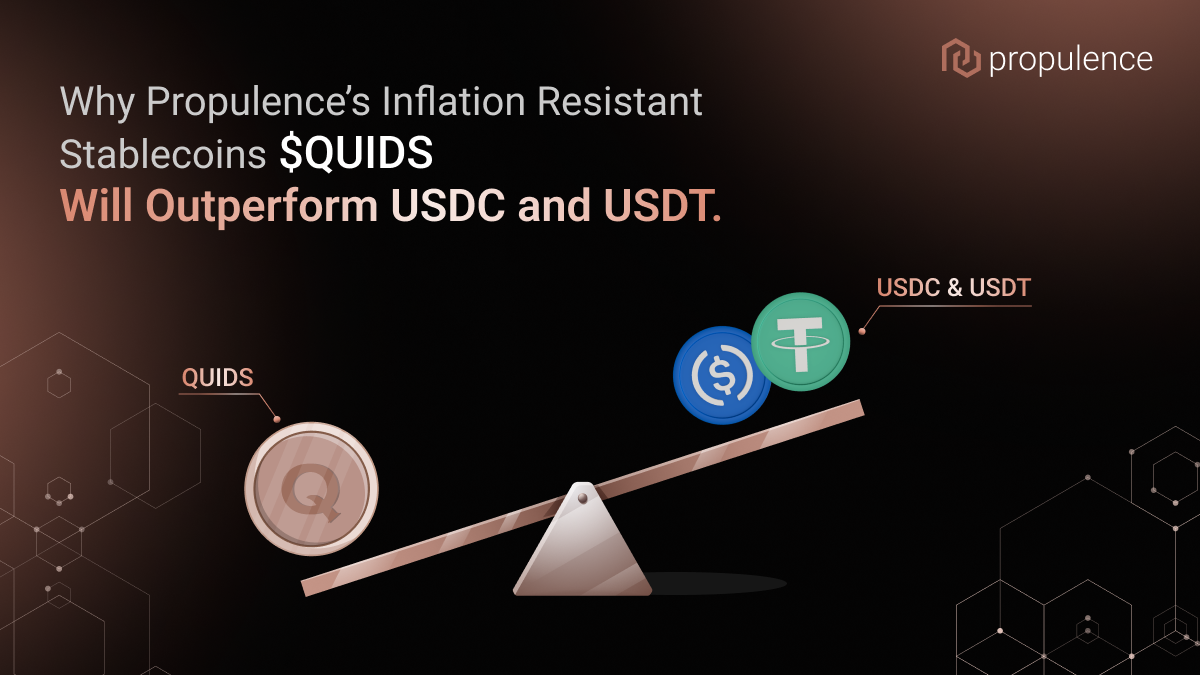How Propulence’s Inflation-Resistant Stablecoins($QUIDS) Outperform USDT and USDC

The Problem With Traditional Stablecoins
Stablecoins like USDT (Tether) and USDC (USD Coin) dominate the cryptocurrency market, with a combined $200+ billion in circulation. However, they share a critical flaw: they are pegged to fiat currencies, which are vulnerable to inflation, devaluation, and central bank policies.
- US inflation reached 3.5% in 2024, eroding purchasing power.
- USDT and USDC holders lose value over time as the dollar weakens.
Propulence solves this problem by introducing the world’s first real estate-backed, inflation-resistant stablecoin - $QUIDS.
The Weaknesses of USDT and USDC
A. Pegged to Depreciating Fiat
- USDT and USDC mirror the USD, which has lost approximately 96% of its value since 1913.
- No inflation hedge—if the USD loses 5% annually, so does your stablecoin.
B. Centralized and Opaque Backing
- USDT: Only 85% backed by "cash equivalents" (commercial paper, loans).
- USDC: Relies on bank deposits (exposing holders to bank failures, as seen in the SVB collapse).
C. No Passive Yield for Holders
USDT and USDC earn 0% interest unless actively lent out (introducing DeFi risks).
How Propulence’s Stablecoin Works?
Propulence’s stablecoin ($QUIDS) is collateralized by income-generating real estate assets, offering key advantages:
A. Inflation Resistance
- Real estate historically appreciates 8–10% annually, outpacing inflation.
- Rental income adjusts with inflation (lease rates rise with CPI), preserving value.
B. Full Transparency and Backing
- Each $QUIDS is backed 1:1 by tokenized real estate (verifiable on-chain).
- Regular third-party audits ensure solvency (unlike Tether’s opaque reserves).
C. Built-In Passive Yield
- Holders earn 5–8% APY automatically from property rental income.
- No need for risky DeFi protocols—yield comes from real-world cash flow.
Direct Comparison: $QUIDS vs. USDT/USDC
Why This Matters for Investors?
A. Long-Term Wealth Preservation
- 10,000 in USDT → 8,600 after 5 years (assuming 3% annual inflation)
- 10,000 in $QUIDS → $18,500+ (5% rental yield + 8% appreciation)
B. Lower Risk Than Banks or DeFi
- No reliance on banks (unlike USDC’s exposure to banking crises).
- No smart contract vulnerabilities (unlike algorithmic stablecoins).
C. Global Accessibility
- Anyone can hold $QUIDS—no need to purchase physical real estate.
The Future of Stablecoins
Propulence’s model has the potential to disrupt the $130B stablecoin market by offering:
- A true store of value (not just a USD clone).
- Passive income without price volatility.
- Unmatched transparency compared to Tether and Circle.
Central banks are already exploring asset-backed digital currencies (e.g., Switzerland’s tokenized bonds). Propulence is pioneering this shift in decentralized finance.
Conclusion: A Stablecoin Designed for Growth
While USDT and USDC are useful for trading, they fail as long-term wealth preservation tools. Propulence’s real estate-backed stablecoin provides:
- Inflation protection through appreciating collateral.
- Built-in yield from rental income.
- Full transparency via blockchain verification.
Learn more about Propulence’s stablecoin:
- Visit the official website: https://www.thepropulence.com
- Join the community discussion on Discord
